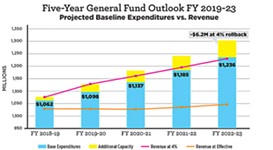Follow the Money
At a time of widening inequality, the city saw a historic increase in social services spending in this year's budget. Who will benefit from increased funding?
By Amy Kamp, Kahron Spearman, and Mary Tuma, Fri., Oct. 23, 2015
As Council prepared for the FY 2016 budget discussion, a number of groups began a concerted effort to convince them to increase social services funding. Two of the most prominent were coalitions One Voice Central Texas and Austin Interfaith.
One Voice is a coalition of nonprofit health and human services organizations. Their mission, as stated on their website, "is to convey the human service needs of the Austin area community to policy makers and the public and to support member organizations in meeting these needs." Their supporters could be seen at council and committee meetings in the weeks before the budget deliberations, asking for increases to the Health and Human Services budget.

Austin Interfaith is part of a larger national network, the Industrial Areas Foundation. It's composed of 43 congregations, public schools, and unions. Kurt Cadena-Mitchell, an AI leader, explains that earlier this year, AI ratified an "agenda of issues" that its members believed needed to be addressed. "Affordability is a struggle," says Cadena-Mitchell. "The city has not prioritized families with children, and it's favored innovation at the cost of labor protections."
The campaigns by large, well-organized groups to increase funding for social services certainly played a role in the final budget (the HHS budget, which encompasses a variety of community services, including workforce development and homeless services, increased by slightly over $8 million), as did the desire of most of the council members and the mayor to prioritize such funding. Cadena-Mitchell says he was "quite pleased" that Council decided to increase the HHS budget, but not surprised. "Austin Interfaith led one of the largest get-out-the-vote efforts in the city," during the 10-1 election. "We're pleased that the council members lived up to the commitments that they made." – Amy Kamp
Job Training: Creating a "Record of Success"
As living in Austin becomes more expensive, it's crucial that its workforce have the skills to be able to earn a living wage. Council allocates funding for job training programs as part of the Health and Human Services budget. Stephanie Hayden, assistant director of the city's Community Services Division, explains that Council makes its decisions to award contracts before it passes the budget; the number included in the budget under "Workforce Development" is simply the total amount of money that will be spent on those contracts.
One job training program routinely funded by the city is Capital IDEA. Cadena-Mitchell says that for every dollar invested in the program, $5 is recouped, because the training and placement that people receive allows them to support themselves, rather than rely on the "social safety net." Capital IDEA is a program open to low-income adults without college degrees. Cadena-Mitchell says that people are making an average of $9/hour when they enter the program, and make an average of $18/hour when they graduate (usually with an associate's degree from ACC). Participants can choose to be trained in one of a handful of careers that Capital IDEA has identified as being in demand and paying a living wage, such as health care, trades, and tech. Capital IDEA covers the tuition, fees, and cost of books for participants in its program; it also assists with child care.
The program currently has 100 slots available for tech training, which will begin in January. In addition to the usual sponsorship participants receive, students who are accepted into the tech training will get paid internships, making $11/hour. Tech careers also have the benefit of being more open to people with criminal records, who tend to have more difficulty than the average person in finding a job. By the time a person has completed their two years of training and internship, says Cadena-Mitchell, they've created a "record of success."
Goodwill of Central Texas got $655,170 from the city for 2016. Reggie Smith, who spent time in prison before eventually being accepted to the University of Texas, says that Goodwill played a large role in his ability to go back to school after he left prison. Getting a job there gave him a chance to not only earn a wage, but also get back into the rhythm of going to work every day.
The Work-Based Learning/Summer Youth Employment Program, funded by the city for 2016 (in partnership with Travis County), creates summer jobs for middle and high school students. Young adults are the most likely to be unemployed, and letting teenagers gain experience while still in school makes it easier for them to find work once they come of age. The program provides jobs – city, county, and private sector – and training for 700 students. Teenagers in the program have a place to go during the summer while their parents are themselves at work, they earn an income, and get a reminder that continuing their education is part of a successful career path.
Cadena-Mitchell says that another component of making sure Austin has a skilled workforce is making sure that children are supported while they're in school. Although it's modestly funded, the VICTORY tutorial program – which pairs students in need of extra help in school with free tutors – helps achieve that goal. Students and tutors meet at the city's branch libraries, most of which are open until 9pm on weeknights, allowing for scheduling flexibility. Some of the tutors are volunteers, while others are college students in work-study programs.
And of course, one of the most celebrated budget victories for workers this year was the city's increased wage – from $11.39 to $13.03 – which applies not only to full-time employees but also part-time and temporary workers. (see "Setting an Example," Sept. 16). – A.K.
Housing: "Never Enough Funding"
While the city's HHS budget saw a historic increase overall, the housing budget within Neighborhood Housing and Community Development (NHCD)remained fairly flat from last budget cycle.
The overall budget stands at $17.4 million to fund community development, affordable housing, and grants for nonprofits and agencies. The housing assistance budget saw a $200,000 bump to $8.4 million due to "citywide cost drivers" and personnel costs. The combined programs targeting affordable housing – including renter, homebuyer, and housing developer assistance funds – are expected to serve more than 3,500 households in the next fiscal year; 2,633 of those are expected to be low-income populations earning 80% of median family income (MFI) or below.
Through all of its programs, the NHCD plans to serve 6,227 households (up from 5,695 last year). The department says its two major priorities are preserving affordable housing stock and tackling chronic homelessness with permanent supportive housing. How well have they succeeded? One key highlight of last year's budget cycle, NHCD notes, is meeting – and surpassing – the 2010 goal of creating 350 new units of permanent supportive housing in four years. Now they set their sights on creating 400 more of these units over the next four years.
With $55 million from the 2006 housing bond depleted, investment now relies on the $65 million 2013 housing bond, a six-year stream of dollars. "Those funds really put our department in stable footing to be able to respond to the development community who could take advantage of our funds and put ownership and rental affordable housing on the ground, but obviously, it's a finite resource," says Rebecca Giello, NHCD's assistant director.
With no major changes from last cycle, the level funding doesn't match the growing need: Occupancy levels average around 98% across the city, with average rent outpacing $1,000 per month, not including utilities. While the city has about 18,500 units of subsidized rental housing, data shows there remains a shortage of some 48,000 units for residents earning $25,000 or less annually, according to 2014 city-commissioned housing market study.
However, Giello expresses enthusiasm about the opportunity for more investment going forward. The space and ability to discuss affordability issues created by the 10-1 council and housing-related committees have opened up new possibilities for engagement. Affordable-housing advocates on Council are helping change the discussion for the better. And new metrics employed by NHCD will help track community performance in offering housing for low-income residents. "What we've never done during policy conversations before is set specific targets and goals, then grade ourselves on how we are measuring up and publish that information," she says. "We can look at where we've made strides, where we can address gaps, and what a capital investment would look like."
And, of course, it would be remiss to rely solely on the NHCD to alleviate the city's affordable housing crisis; they are a slice of the larger picture. It is certainly a group effort – a point Giello stresses – with other departments and dedicated nonprofits working in tandem to relieve burdened homeowners and struggling renters. For instance, $350,000 was diverted from the Code Department to fund the Residents' Advocacy Project (see "A Voice for Tenants," Oct. 2), meant to assist renters living in substandard housing. The increase to the HHS budget includes more money for social service contracts to combat homelessness. "The Health and Human Services budget change is really dramatic and will help many of the same families that live in affordable housing," says Walter Moreau of Foundation Communities.
Yet even with all the assistance, housing advocates, keenly aware of the shortage on a daily basis, feel the investment can be greater. "The truth is, there is never enough funding," says Mandy De Mayo, executive director of HousingWorks. With federal resources from the Housing and Urban Development (HUD) dwindling over the years, and local needs rising, De Mayo says the city budget still has yet to truly catch up with the growing community void for affordable housing. In light of this, she says, it's vital to utilize policy tools that can help: "It's also important not to look just at dollars, but look at the programs and policies in place that increase affordability." For example, De Mayo points to the city's density bonus programs that cost the city no extra fees. In exchange for extra density, developers can build affordable housing on-site, or opt to pay into a fund intended to support affordability. Council Member Kathie Tovo is pushing to ensure developers actually build affordable units on-site (or at least recalibrate the fee to make it more equitable) to widen options for low-income residents in all parts of town (see "Bonus Points for Affordability," Oct. 2). During last Thursday's council meeting, the process kicked off: A resolution calling for an analysis of the city's density bonus programs – to be released in January – passed, with only one "no" vote (CM Don Zimmerman). – Mary Tuma
Health Services: A Growing Need
"As we watched police[-related considerations] and other important departments, a bunch of libraries or animal institutes [get funded], it's good to know they're actively lobbying for more increases, which is important, because Austin keeps growing," says Moreau with a subdued optimism.
He continues, speaking on the approximately 11% increase approved in the FY 2016 budget: "Typically, the nonprofit agencies in town go into the budget on our hands and knees, begging and hoping that there will be enough just to do 1 percent or 2 percent [increase]. For 25 years, I've never seen the Health and Human Services budget keep up with the population growth."
But now, in Austin's current economic boom, the majority of the new council took much-needed action. Disease Prevention & Health Promotion saw a net increase of $2,606,514 from last year's budget, while Maternal, Child, & Adolescent Health saw a net increase of $1,333,758, and Social Service Contracts saw a net increase of $3,153,710. Boosts in Healthy Food initiatives, additional staffing in areas of need, rental assistance, design of a new community center and women's shelter, and other earmarked items were added, along with unspecified open funding.
The optimism is tantalizing, and city leaders will – and should – tout this as a definitive victory for lower-income residents who have a desperate need for these services. However, there are some considerable reasons for pause, and for full consideration of what the health services augmentation means in the changing phases (and faces) of Austin's troublesome duality.
"We feel like it's a good start," says Kellee Coleman, program coordinator at the Mama Sana/Vibrant Woman prenatal clinic. "Our Austin/Travis County Health and Human Services Department has been grossly underfunded. We've had a lot of programs that have come and gone, whether or not they worked because of [lack of] funding. [But] we're still not up to par," she cautions. "Where it gets murky is, are we going to be able to hold the city accountable to make those increases every year and to fund programs and projects that the city actually needs?"
Also, where will the services be located? And how will the changing face of Austin influence and count toward the future, in regards to health services? As is well documented: African-Americans are moving out of the city, by choice or via old-fashioned pricing out by way of the ongoing gentrification. "That doesn't mean that they're moving out of Central Texas," says Moreau. "It could be the suburbs or beyond, well beyond. Or, unincorporated parts of the county."
Austin's lower-income residents continually find themselves unable to afford housing, or escalating prices of quality foods – two significant determinants of healthy outcomes. (See "Beer, Cigarettes, and ... Vegetables?" Oct. 23, for more on the city's Healthy Corner Store Initiative, which is aimed at increasing access to fresh produce.) Now moving into Del Valle, Manor, Pflugerville, and the "unincorporated" hinterlands of Austin's new outback, these "residents" will likely be farther away with each passing year. This will create an immediate need for amplified health care outreach, requiring efficient use of further increased funding.
According to the American Community Survey, Austin's population will be younger and darker going forward. Unless new equity measures are taken, it will also be poorer. 2014 estimates show whites account for 29% of those under the age of 10, but 65% of those aged 55-65 (and over). The out-of-state influx, the move to the suburbs, and gentrification will affect these numbers, but likely in the early-to-mid professional ranges. Given the relocation, but darkening, of what will eventually become the majority in Austin/Travis County, combined with financial inequities, there's a chance of something of an economic apartheid – a dark crescent edging Downtown and the affluent west side. The convergence of factors isn't accidental.
"The way that the city has been structured, economically, is for the white creatives [to thrive]," says Coleman. "That's what it's been structured around UT. "
The population most affected will be the children from lower-income areas that are already lacking in other critical resources, such as education – mostly likely black or Latino, but also white. Robin Herskowitz, founder and executive director of Healthstart, a nonprofit focused on empowering positive health in children, says we must engage in solution-based proactiveness.
"I'd like to see the city take a bigger role in providing funding for programs that are preventative in nature. There are significant needs for preventive health care. Significant needs for programs to help kids catch up. If we do that properly, we should be in a position to ensure that kids across the spectrum – families across the spectrum – can participate in the great boom."
While the racial aspect of Austin's changes will remain at the forefront, accompanying class issues cannot be ignored. The sizeable HHS increases, among those made for Latino and African American Quality of Life measures, only signify the first rung of a wobbly ladder representing Austin's re-entrant climb to its advertised and marketed progressiveness. – Kahron Spearman
Austin's Health and Human Services Budget
| FY 2015* | FY 2016** | |
| Total Budget | $3.5 billion | $3.5 billion |
| HHS Budget | $76.9 million | $85.2 million |
* Amendments made by Council throughout the year, normally due to changes in grants
** Approved at the beginning of the fiscal year, not amended to date
Got something to say on the subject? Send a letter to the editor.



















